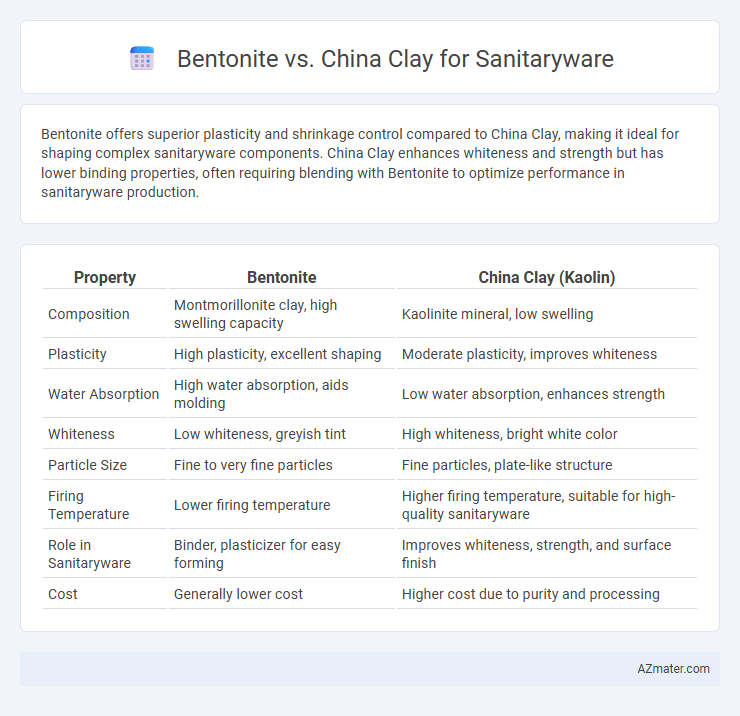Bentonite offers superior plasticity and shrinkage control compared to China Clay, making it ideal for shaping complex sanitaryware components. China Clay enhances whiteness and strength but has lower binding properties, often requiring blending with Bentonite to optimize performance in sanitaryware production.
Table of Comparison
| Property | Bentonite | China Clay (Kaolin) |
|---|---|---|
| Composition | Montmorillonite clay, high swelling capacity | Kaolinite mineral, low swelling |
| Plasticity | High plasticity, excellent shaping | Moderate plasticity, improves whiteness |
| Water Absorption | High water absorption, aids molding | Low water absorption, enhances strength |
| Whiteness | Low whiteness, greyish tint | High whiteness, bright white color |
| Particle Size | Fine to very fine particles | Fine particles, plate-like structure |
| Firing Temperature | Lower firing temperature | Higher firing temperature, suitable for high-quality sanitaryware |
| Role in Sanitaryware | Binder, plasticizer for easy forming | Improves whiteness, strength, and surface finish |
| Cost | Generally lower cost | Higher cost due to purity and processing |
Introduction to Bentonite and China Clay
Bentonite is a highly absorbent clay primarily composed of montmorillonite, known for its swelling properties and excellent plasticity, making it ideal for enhancing the workability and strength of sanitaryware products. China clay, also called kaolin, consists mainly of kaolinite and is prized for its whiteness, fine particle size, and inert behavior, contributing to the smooth surface finish and durability of sanitaryware. Both clays are essential raw materials in the ceramic industry, with bentonite improving shaping and moisture retention while China clay ensures optimal whiteness and firing performance.
Chemical Composition Comparison
Bentonite primarily consists of montmorillonite clay minerals rich in silica (SiO2), alumina (Al2O3), and a significant amount of water within its structure, making it highly absorbent and swellable. China clay, also known as kaolin, is composed mainly of kaolinite with a chemical formula Al2Si2O5(OH)4, characterized by lower swelling capacity and higher purity in alumina content compared to bentonite. The differing chemical compositions influence their properties in sanitaryware production: bentonite enhances plasticity and binding due to swelling, while china clay improves whiteness and strength with its fine particle size and stable structure.
Physical Properties and Plasticity
Bentonite exhibits superior plasticity and swelling capacity compared to China clay, making it highly effective for improving green strength and shaping in sanitaryware production. The fine particle size and high cation exchange capacity of Bentonite enhance its binding properties, resulting in better moldability and surface finish. In contrast, China clay offers excellent whiteness and low plasticity, often requiring blending with Bentonite to achieve optimal workability and dimensional stability.
Role in Sanitaryware Manufacturing
Bentonite acts as a crucial binder and plasticizer in sanitaryware manufacturing, enhancing the shaping and green strength of ceramic bodies. China clay, rich in kaolinite, improves the whiteness, plasticity, and firing characteristics, contributing to a smooth surface finish and mechanical strength. Both minerals optimize the rheology and sintering properties but serve distinct roles in achieving durability and aesthetic quality in sanitaryware products.
Impact on Casting Performance
Bentonite enhances casting performance in sanitaryware by improving the plasticity and binding strength of the clay body, leading to better mold release and surface finish. China clay, or kaolin, primarily contributes to the whiteness and thermal stability but offers less plasticity, which can result in more shrinkage and potential cracking during drying and firing. Optimizing the ratio of bentonite to china clay balances the casting slurry's rheology, reducing defects and improving the dimensional accuracy of sanitaryware products.
Effects on Fired Product Strength
Bentonite enhances fired product strength in sanitaryware by improving plasticity and particle bonding, resulting in higher mechanical durability and resistance to cracking. China clay, while providing a smoother surface finish, offers less contribution to fired strength due to its lower binding properties compared to bentonite. Optimizing the ratio of bentonite to china clay is crucial for achieving a balanced combination of strength and surface quality in fired sanitaryware products.
Influence on Surface Quality and Finish
Bentonite enhances the plasticity and green strength of sanitaryware clays, leading to improved moldability but can cause surface defects such as blisters if not properly processed, impacting the final finish. China clay, rich in kaolinite, provides superior whiteness and smoothness, contributing to a fine surface texture and better glaze adherence, which elevates the aesthetic quality of sanitaryware products. The balance between bentonite's binding properties and china clay's whiteness is critical for achieving optimal surface quality and a durable, high-gloss finish in sanitaryware manufacturing.
Cost Differences and Economic Considerations
Bentonite generally offers lower raw material costs compared to China Clay, making it a cost-effective option for sanitaryware manufacturing. However, China Clay provides superior whiteness and plasticity, which can enhance product quality and reduce firing temperatures, potentially lowering overall production expenses. Economic considerations should balance initial material costs with long-term benefits in energy savings and product durability.
Environmental and Processing Factors
Bentonite offers superior plasticity and water absorption properties, reducing water consumption during sanitaryware production and minimizing wastewater discharge. China clay provides a smoother texture but requires higher processing temperatures and energy, leading to increased carbon emissions. Environmentally, bentonite's natural swelling capacity enables more efficient molding with less mechanical energy, while china clay's finer particle size demands extensive refinement, resulting in higher resource use and environmental impact.
Conclusion: Which is Better for Sanitaryware?
Bentonite offers superior plasticity and binding properties ideal for sanitaryware production, providing enhanced moldability and strength compared to China Clay. China Clay, while beneficial for its whiteness and smooth texture, lacks the necessary rheological properties that Bentonite delivers for optimal shaping and drying processes. Therefore, Bentonite is generally preferred in sanitaryware manufacturing due to its ability to improve product durability and surface finish.

Infographic: Bentonite vs China Clay for Sanitaryware
 azmater.com
azmater.com